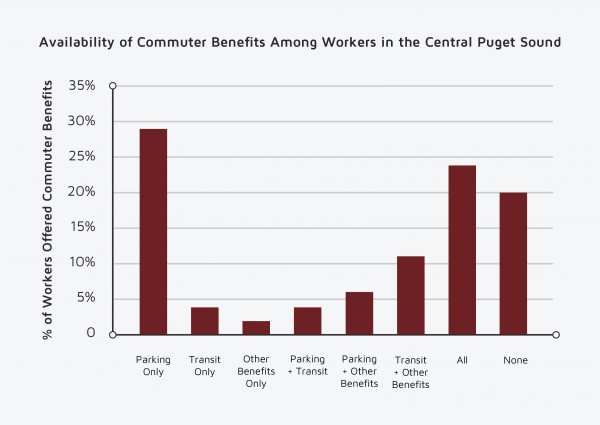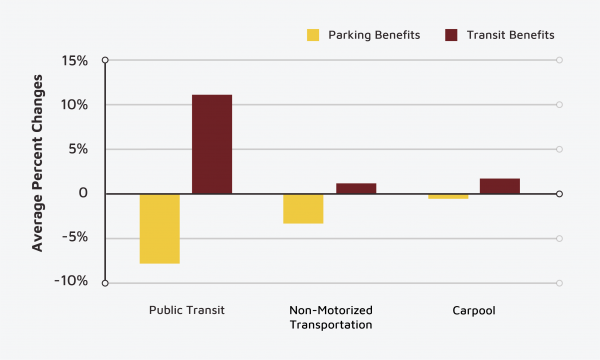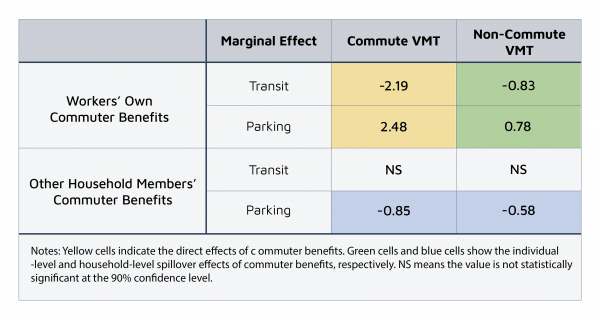
Commuter Benefits and Driving: Direct and Spillover Effects
How employers can encourage travel behaviors beyond commuting
Commuter benefits are fringe benefits that firms give to workers to reduce the costs of commuting. The most common of these benefits — free parking — probably encourages employees to drive. In recent years, however, a growing number of state and local governments, such as Washington, D.C. and San Francisco, have passed laws requiring employers of a certain size to offer their employees commuter benefits for alternative modes of transportation (e.g., subsidies for transit or vanpool expenses, or a company-funded bus). These laws primarily aim to address environmental concerns and traffic congestion problems that are especially severe in city centers. These benefits could increase use of these alternative modes, and thereby increase environmental sustainability and social equity.
Despite the growing attention to commuter benefits programs, little is known about their comprehensive effects. Prior investigations have focused only on how benefits influence workers’ choice of commuting mode (e.g., does a transit benefit make them less likely to drive, and more likely to ride transit?). It is possible, however, that the effects of commuter benefits can extend beyond commute decisions, and even beyond workers. Benefit programs might influence how workers travel for non-commuting trips, or they might influence how other people in their households decide to travel. But these latter ideas remain largely unexamined.
Motivated by these ideas, my research explored three related questions: (1) Are employer-based commuter benefits associated with workers’ commute behavior?; (2) Are commuter benefits associated with workers’ non-commute behavior (i.e., is there an individual-level spillover)?; and (3) Are commuter benefits associated with the travel behavior of workers’ household members (i.e., is there a household-level spillover)? To answer these questions, I compared the mode choice and vehicle miles traveled (VMT, a measure of total driving) of commute and non-commute trips, for workers who did and did not have their own and other household members’ commuter benefits. The area I studied was the central Puget Sound region in Washington state, which includes Seattle and its surrounding areas (King, Pierce, Snohomish, and Kitsap counties).
My data came from the 2014 Puget Sound Regional Travel Survey (PSRTS) that collected information from approximately 12,000 individuals about how the region’s residents travel. The survey also collected information on household socioeconomics, and — crucially — on whether commuters were offered any of the following benefits: free/subsidized automobile parking, free/subsidized transit benefits, and commuter benefits other than parking and transit benefits (e.g., subsidies for vanpools, bike storage).
Figure 1 shows that the availability of commuter benefits varied greatly across workers. About one in five workers reported being offered no commuter benefits, and a similar proportion reported being offered all three types. Parking was the dominant commuter benefit provided by employers in the central Puget Sound region. Nearly two-thirds of workers reported being offered parking benefits, whereas fewer than half had access to transit or other benefits. About two-thirds of workers offered transit benefits were also offered parking benefits.
Figure 1. Availability of different types of commuter benefits in the final sample

Commuter Benefits and Commuter Choices
My findings support earlier research showing that workers with transit benefits are less likely to drive alone to work. My findings also support earlier research suggesting that workers with parking benefits are more likely to drive alone to work. Figure 2 reports the average changes in the probability of commuting by each transport mode when workers are offered a certain type of commuter benefit. On average, the probability of a worker commuting by transit increases by approximately 11% when that worker is offered transit benefits, whereas it decreases by approximately 8% when the worker is offered parking benefits. Being offered transit benefits also increases the average probability of commuting by carpool or non-motorized transportation, although the magnitude of these effects is much smaller. This is probably because those who do not drive to work can easily choose a different travel mode for each commute trip. For example, even if workers take transit to work to utilize transit benefits, their co-workers could give them a ride home after work or they may walk home for exercise. For those who drive alone to work, however, they are less likely to change their commuting mode after work because they need a car in the morning.
Figure 2. Average changes in the probability of commuting by each transport mode when a worker is offered commuter benefits

But do these commuter benefits also change workers’ non-commute travel behavior? My data suggest that answer is yes: both transit and parking benefits influence non-commute travel. They do so, moreover, in the same direction they influence commute travel. In other words, employees with transit benefits drive less, not only for work but also for non-commute purposes. Conversely, those offered parking benefits by employers are more likely to drive for both work and non-work trips.

Employees with transit benefits drive less, not only for work but also for non-commute purposes.

Why would a commute benefit influence non-commute travel? One possible explanation is that a third of non-work trips still originate from the workplace. People might use their lunch break, for example, to run some errands or go to a medical appointment. It may be most convenient for workers making these trips to use the same mode they used for commuting (e.g., if you drove to work you are more likely to drive if you run out an errand). Similarly, non-commute trips are also frequently linked to commutes: people stop at shops or gyms or schools on the way to or from work. Such trip-chaining is much easier with a car, which may help explain why those offered parking benefits are more likely to drive for non-commute purposes. Finally, workers offered commuter benefits may also cultivate new non-commute travel habits. People who learn the bus or rail system because of a commuter incentive, for example, might realize they can use transit to reach other destinations as well.
Commuter Benefits and Household Members’ Travel Behaviors
Commuter benefits are also associated with the travel behaviors of the commuters’ household members, but this relationship is more complicated, and in some ways more surprising. Specifically, parking benefits are associated with a decrease in driving distance among commuters’ working household members. If a worker has parking benefits, then other members of the household are less likely to drive alone to work, and if they do drive they will drive less. The most likely explanation for this finding is that in a household with less than one vehicle per working household member, workers offered parking benefits seem to have priority access to the household vehicle.
With transit benefits, the behavior of other household members is more straightforward. People who don’t work, but who live in a household with someone whose work gives them transit benefits, tend to drive less. This spillover can be partly explained by the fact that workers who are offered transit benefits tend to live in neighborhoods with greater transit access and higher population density, which likely encourages their non-working household members to use transit more and drive less. It may also be explained by learning behavior: people who watch a household member use transit regularly might be more likely to start using it themselves.
At this point, readers might be wondering about the relative magnitude of the different types of spillover and direct effects of commuter benefits: how do they net out? Does a household with parking or transit benefits drive more or less than a household without those benefits? To answer this question, Table 1 reports the marginal effects — the association of workers’ own and other household members’ commuter benefits with typical workers’ driving distance. For example, offering a transit benefit to the average worker is associated with a decrease in daily driving distance by approximately three miles, about 72% of which is related to commutes.
Table 1 also shows that overall, parking benefits have a positive association with driving. Even though parking’s spillover onto other household members is associated with less VMT, that reduced amount of driving is more than outweighed by the increase in driving associated with the commuters themselves. The primary impact of parking benefits appears to be substantially more driving by the person who has them, which leads to more household driving overall.
Table 1. Marginal effect of commuter benefit programs on worker’s VMT

Key Lessons for Policymakers
In the central Puget Sound region, as in most other U.S. regions, planners tend to evaluate commuter benefit programs by observing the commute behavior of employees. If commuter benefit programs also influence employees’ non-commute trips, however, and the trips of other household members, then conventional evaluations might understate their impacts.

If commuter benefit programs also influence employees’ non-commute trips and the trips of other household members, then conventional evaluations might understate their impacts.

Moreover, as the positive association between parking benefits and driving distance remains almost the same after considering the spillovers between commute and non-commute trips and across household members, policymakers should discourage employers from providing parking benefits, or discourage employees from using the parking benefits they are offered. One potential strategy is to require employers to offer a parking cash-out, which is known to significantly reduce solo-driving among workers. For example, in 1992, California enacted a law mandating that some employers give their employees an option of a cash allowance in lieu of parking subsidies, and scholars have demonstrated that this has been effective in discouraging employees from driving to work.
Lastly, but most importantly, because my findings indicate that commuter benefits for transit use are more effective in reducing VMT than previously known, policies are needed to encourage more employers to provide such benefits. More than half of the 2014 Puget Sound survey respondents reported having no access to transit benefits (see Figure 1). Therefore, policymakers should develop tools, such as the provision of administrative or financial support, to urge more employers, especially those located in congested areas, to provide transit benefits.